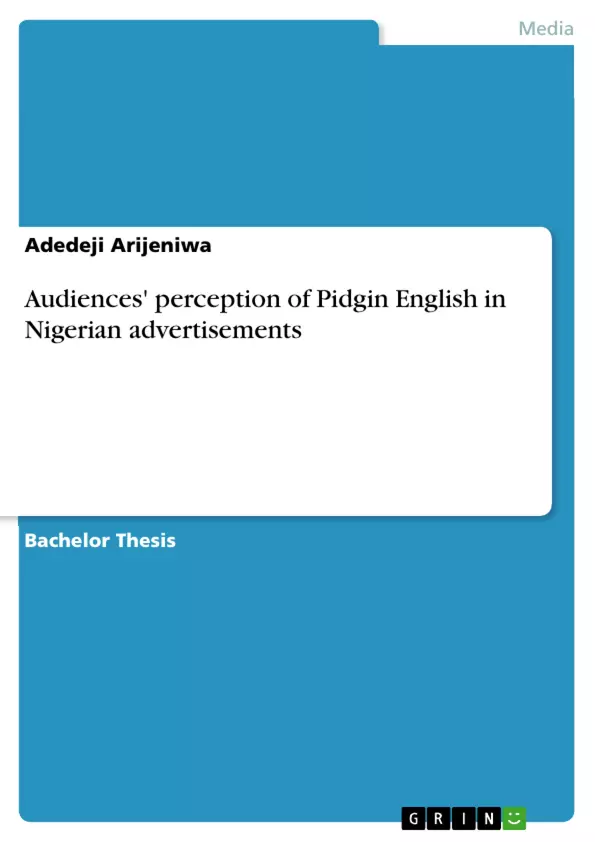In a world of fierce competition and the emergence of the internet as a powerful, borderless medium, gaining and retaining the attention of consumers and customers and persuading them to buy products and services through the broadcast media is becoming more challenging and important.
Although advertising has been proven to be effective in providing market information about products and services, its understanding and comprehension by the masses has been questioned consistently. Thus, it is important for advertisers, advertising agencies, and the media to understand the role that languages play in reaching the target market audience with simple market information about products.
This research examines audience perception of Pidgin English advertisements in Nigerian broadcast media, using Benin-City as a reference point. The inhabitants of Benin-City municipal are mainly businessmen and women of various ethnic backgrounds, mostly Hausas, Igbos, and Yorubas. Hence, the use of Pidgin English is regarded as the best medium of public interaction and communication in carrying out their daily activities. These people mostly understand the surface structure of communicated messages in Standard English, while several others cannot even comprehend them at all.
Hence, this study examines if Pidgin English holds the interest of the audience when used as a vehicle for conveying advertising messages by the advertisers via the broadcast media and also found out if Pidgin English can help decrease misconception and misunderstanding as regards advertised products. It also intends to explore the potential of the Nigerian Pidgin English as a language as a medium of public and mass communication in Nigeria.
A survey research method was adopted in the study, and 200 well-structured questionnaires were administered to purposively selected respondents at random. Data gathered was analyzed using frequency counts, and simple percentages.
Findings showed that Pidgin English usage in advertisements helps to reduce misconceptions and misunderstandings of advertisement information and also holds the interest of the audience when used as a medium of communication. Based on the findings, it was that the use of Pidgin English in advertisements should be encouraged. The study also recommends further study to find out whether the public would embrace the culture of using Pidgin English more often for broadcast programs and perhaps adopt it as one of the country’s lingua franca.
Inhaltsverzeichnis (Table of Contents)
- Chapter One: Introduction
- 1.1 Background to the Study
- 1.2 Statement of the Problem
- 1.3 Objectives of the Study
- 1.4 Research Questions
- 1.5 Significance of the Study
- 1.6 Scope and Delimitation of the Study
- 1.7 Definition of Terms
- Chapter Two: Literature Review
- 2.1 The Concept of Pidgin English
- 2.2 Varieties of Pidgin English
- 2.3 Pidgin English in Nigerian Broadcast Media
- 2.4 Audience Perception of Pidgin English Advertisements
- 2.5 Theoretical Framework
- Chapter Three: Research Methodology
- 3.1 Research Design
- 3.2 Population of the Study
- 3.3 Sample and Sampling Technique
- 3.4 Instrument for Data Collection
- 3.5 Method of Data Collection
- 3.6 Method of Data Analysis
- Chapter Four: Data Presentation, Analysis and Interpretation
- 4.1 Presentation of Data
- 4.2 Analysis of Data
- 4.3 Interpretation of Data
- Chapter Five: Summary of Findings, Conclusion and Recommendations
- 5.1 Summary of Findings
- 5.2 Conclusion
- 5.3 Recommendations
Zielsetzung und Themenschwerpunkte (Objectives and Key Themes)
This research project investigates the perception of Pidgin English advertisements by audiences in Benin-City, Nigeria. The study aims to explore the impact of Pidgin English on advertising effectiveness and audience engagement. The research seeks to understand how audiences perceive the use of Pidgin English in advertising and whether it influences their purchasing decisions. The study will also examine the social, cultural, and linguistic implications of Pidgin English in the context of advertising.
- The use and effectiveness of Pidgin English in advertising
- Audience perception of Pidgin English advertisements
- The impact of Pidgin English on advertising effectiveness
- The social and cultural implications of Pidgin English in advertising
- The linguistic features of Pidgin English used in advertisements
Zusammenfassung der Kapitel (Chapter Summaries)
Chapter One provides an introduction to the study, including background information, statement of the problem, research objectives, research questions, significance of the study, scope and delimitation, and definition of key terms.
Chapter Two presents a comprehensive literature review on Pidgin English, its varieties, its use in Nigerian broadcast media, and audience perception of Pidgin English advertisements. This chapter also discusses the theoretical framework guiding the research.
Chapter Three outlines the research methodology, including research design, population, sample and sampling technique, instrument for data collection, method of data collection, and method of data analysis.
Chapter Four presents, analyzes, and interprets the data collected through the research. This chapter examines the findings in relation to the research questions and objectives.
Schlüsselwörter (Keywords)
The primary keywords and focus topics of this research include Pidgin English, advertising, audience perception, Nigerian broadcast media, Benin-City, language, culture, communication, advertising effectiveness, and audience engagement. These terms encapsulate the core concepts and themes explored throughout the study, highlighting the importance of understanding the role of Pidgin English in advertising and its impact on audiences.
- Quote paper
- Adedeji Arijeniwa (Author), 2017, Audiences' perception of Pidgin English in Nigerian advertisements, Munich, GRIN Verlag, https://www.grin.com/document/1281767



